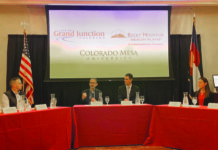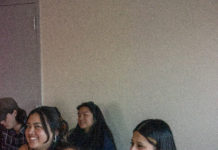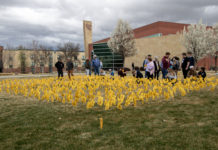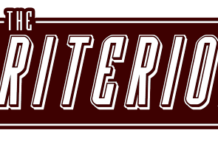With the expansion of campus, vacated streets including College Place, Houston, Bunting, Elm and Cannel, no longer exist but are still used as addresses for Colorado Mesa University buildings. A proposal was sent to CMU in 2014 to update the addresses, with little response back from CMU. Afterwards, a group of students looked into the addresses and met with the city’s addressing committee in hopes of finding a solution, but nothing more came out of that, either.
“As the campus expands and new buildings are built, there are no longer right of ways and there are streets that no longer exist next to buildings,” Grand Junction Associate Planner Senta Costello said. “Having those addresses off a vacated right of way is somewhat important but all the other things we have in place make it a lower priority.”
The technology of Master Street Address Guide(MSAG), Automatic Location Identifier (ALI), and first responder mobile units help locate a call on a GPS map. Dispatchers and first responders also use common places.
“If we receive a call and a person says they are at a building on CMU campus, first responders can type the name of the building into their units, and in return, it will show the address as well as where it is at on campus,” Grand Junction’s GIS Systems Network Analyst Jackson Trappett said. “Commonplaces are one of the biggest tools they use. It is a lot quicker for them to get help.”
The MSAG is a tabular list of addresses, including the address, street name, and address range. The ALI, their sister software, has every phone number listed. If a call is made, it will connect it to the MSAG record. Furthermore, most mobile devices will send the latitude and longitude of their location.
“Addressing is not easy,” Communications Center Manager Paula Creasy said. “That’s why we have so much built into our system.”
In addition, dispatchers and first responders have access to pre-plans that include names of buildings, layout of buildings, fire hydrants, reinforced areas built for fire trucks to drive on, structure of the building and entrances and exits.
“The challenge is there are no streets there,” Vice President of Student Services John Marshall said. “Realistically when you make a call, the ambulance and police have to know where the buildings are, whether its 12th St., Elm, or College Place, none of those exist in the middle of the campus. What they really need is a strong working knowledge of the campus.”
CMU has a Safety Day, as well as training exercises during the summer for dispatchers and first responders where they receive tours, spend time on campus and practice fire drills.
“It is a challenging situation because you do have a large campus that has a lot of internal buildings that don’t front on a street,” Costello said. “If CMU has any addressing schemes, we are all ears. Ultimately, we just don’t want someone to get hurt and if they do, 911 can find them.”
The committee’s proposed ideas varied from using addresses off the nearest street-based off the city addressing grid block to labeling large sidewalks.

“Looking at the future for the university, it shows that all between 12th and 7th and North and Orchard being vacated eventually,” Trappett said. “We want to keep trying to come up with some addresses that will make sense as this continues and we are open to other proposals.”
With CMU focused on working to familiarize first responders with campus rather than assigning addresses to buildings that are not situated near city streets, the addressing committee and the university do not currently see eye-to-eye on the issue. The issue may become resolved in the future if both sides find a system that makes sense to each of them.





